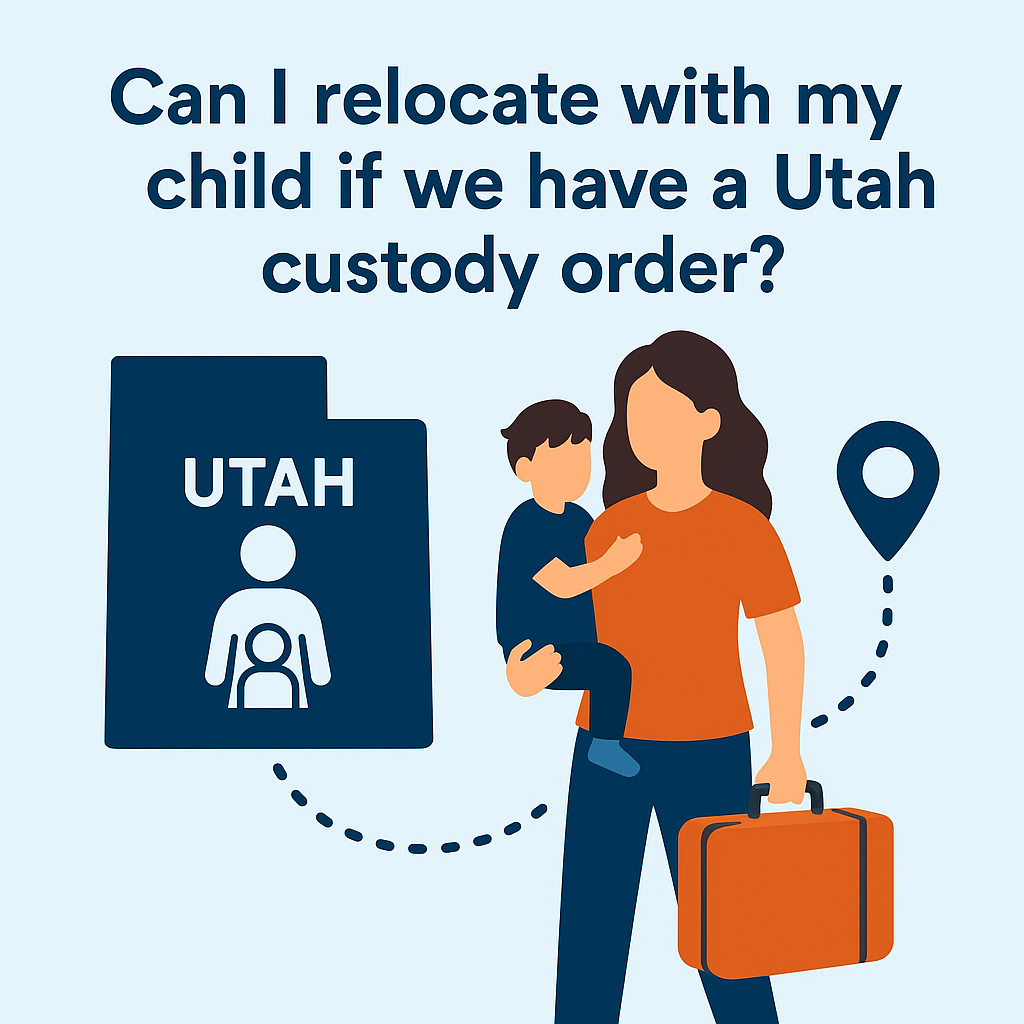Relocating With a Child Under a Utah Custody Order
A plain-English guide to notice, best-interest factors, modification filings, temporary orders, and evidence
If you want to relocate with your child under a Utah custody order, you must follow strict notice rules, meet “best interest” standards, and often request a modification of your custody arrangement. Relocation cases are among the most sensitive issues in family law because they affect a child’s stability and both parents’ rights.
This guide explains how relocation works in Utah, from giving notice and filing the right paperwork to the best-interest factors judges apply. You’ll also see common mistakes, practical evidence tips, and how temporary orders work while your case is pending—so you can move forward with clarity and confidence.
Relocation Basics & Notice Requirement
Give written notice at least 60 days before the move. Your notice should include: (1) your intended move date, (2) the new address if known, and (3) a proposed parent-time schedule after the move.
60-Day Written Notice
Deliver written notice to the other parent with move date, new address (if known), and a proposed schedule.
Be Complete & Transparent
Incomplete notice hurts credibility and can delay or derail a relocation request.
Set the Tone
Notice is the starting point. It signals to the court that you’re following the rules and acting in good faith.
Best-Interest Factors Judges Consider
Notice isn’t the end of the story. The court still decides whether relocation is in the child’s best interest. Judges weigh several Utah-specific considerations.
Reason & Distance
Why the move is needed and how far you’re going. Courts consider job offers, family support, education, safety, and stability.
Impact on the Child
Schooling, community ties, medical care, and the child’s relationships and routine.
Bond With Both Parents
Whether meaningful, ongoing parent-time can be preserved with a realistic schedule and travel plan.
Child’s Preference
Sometimes considered if the child is mature enough to express a reasoned choice.
Co-Parenting History
Patterns of cooperation or conflict. Courts look for good-faith problem solving, not point-scoring.
Filing to Modify Custody or Parent-Time
If the other parent objects, you’ll usually file a Petition to Modify Custody or Parent Time. This opens a formal case where you explain why the move is necessary and propose a workable schedule. Courts commonly require mediation before a judge makes a decision.
Use mediation to refine logistics: travel costs, school breaks, video calls, and holiday rotations. Specifics prevent future conflict.
Temporary Orders During the Case
Housing & School
Interim Parent-Time
Costs & Logistics
Evidence Tips
Document the Reason
Job offer letters, pay details, housing information, family support, safety considerations, and community resources.
Show Child Benefits
School ratings, program availability, medical providers, childcare plans, and special services in the new area.
Preserve Relationships
Provide a detailed, practical parent-time plan with travel, holidays, summers, and regular video calls.
Communicate Well
Keep messages respectful and child-focused. Avoid inflammatory remarks that can surface as exhibits.
Video & Social Learning Hub
Quick Checklist
Give 60 days of written notice with move date, new address (if known), and a proposed parent-time schedule.
Review best-interest factors: reason for move, distance, schooling, relationships, and preserving bonds.
If the other parent objects, file a Petition to Modify and be ready for mediation.
Prepare evidence: job offers, school details, housing, medical access, and support network.
Follow temporary orders exactly and demonstrate flexibility and good-faith problem solving.
This page is legal information, not legal advice. When in doubt, get counsel before you move.
FAQs
Q: What if the judge denies relocation?
A: You can still move on your own, but not with your child. Custody may shift to the parent remaining in Utah.
Q: Do I still pay child support if custody changes?
A: Yes. Child support continues. If custody changes, the court issues a new order adjusting payments.
Need Help Applying This to Your Situation?
Every family is unique, and Utah courts review relocation cases individually. A short consult can help you avoid mistakes and delays.
Talk to a Utah AttorneyGet guidance on notice timing, modification filings, travel logistics, and building a strong evidence record.
